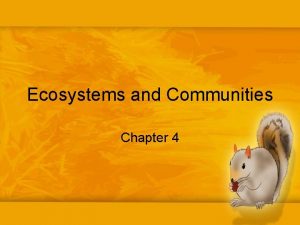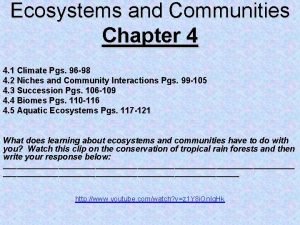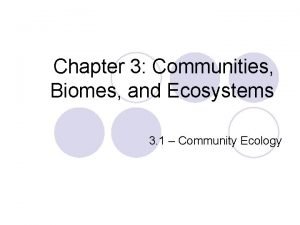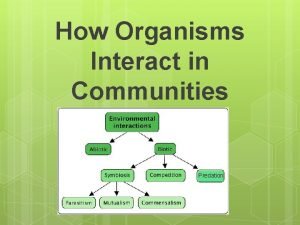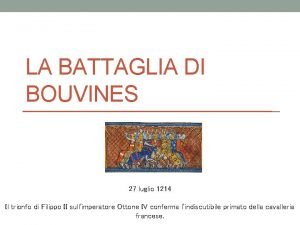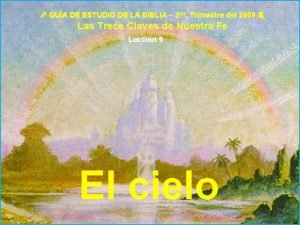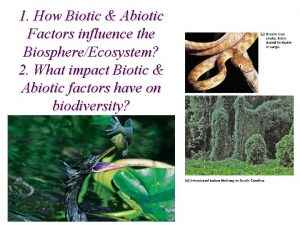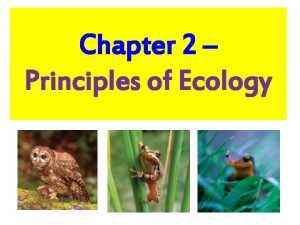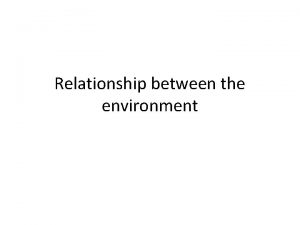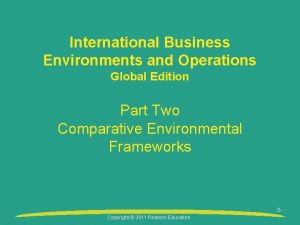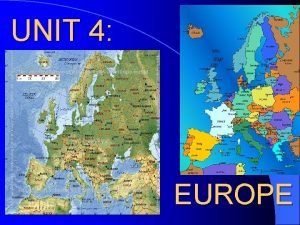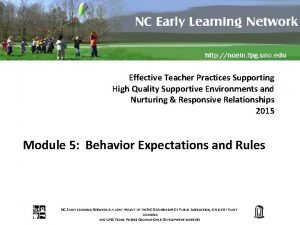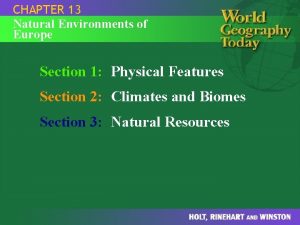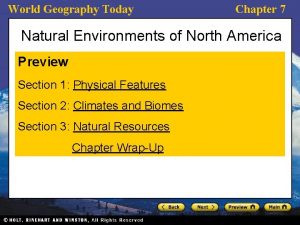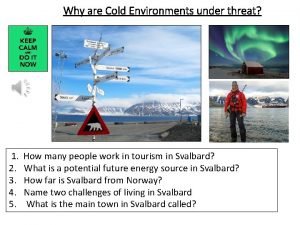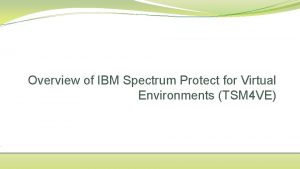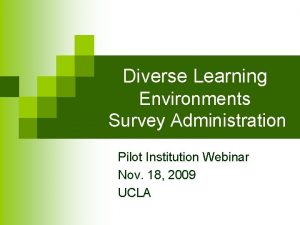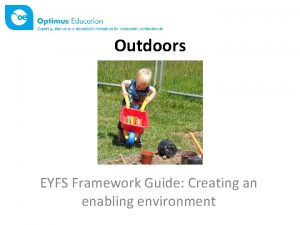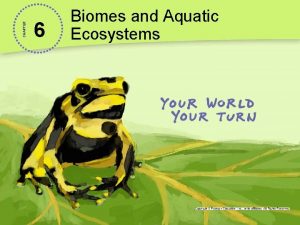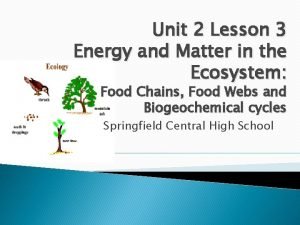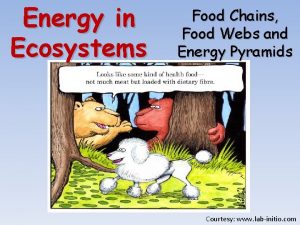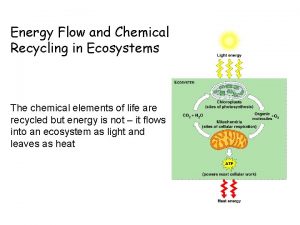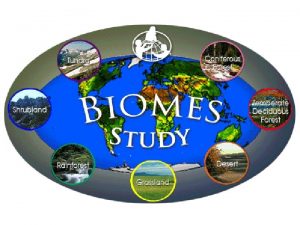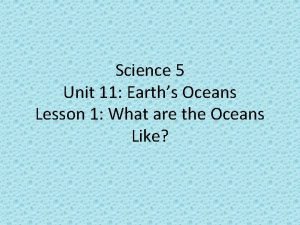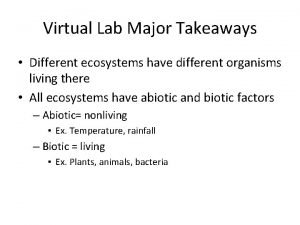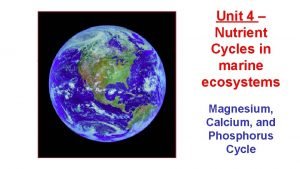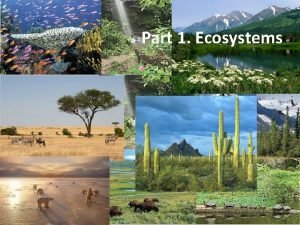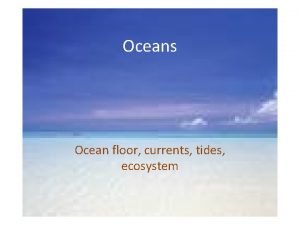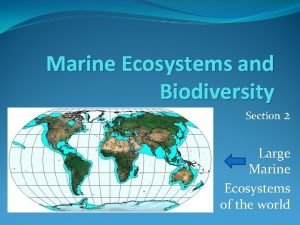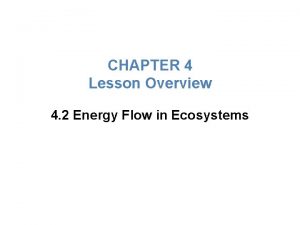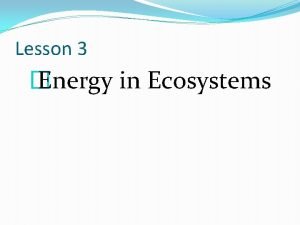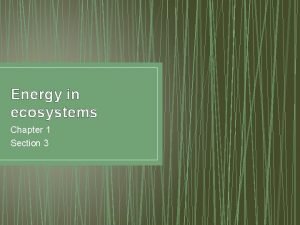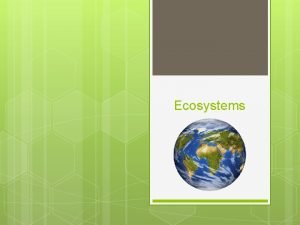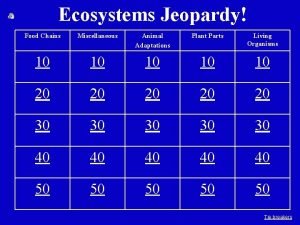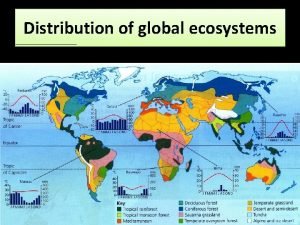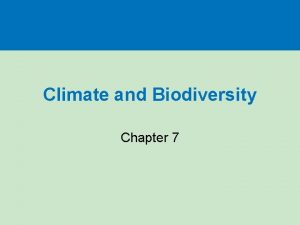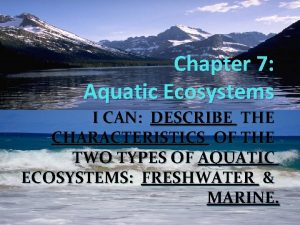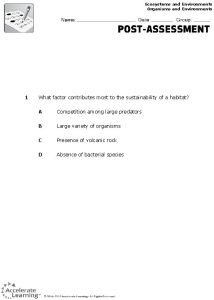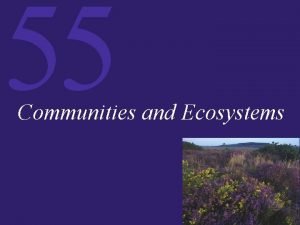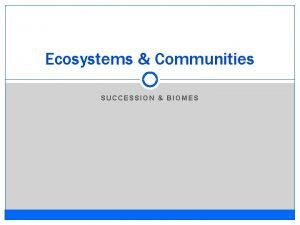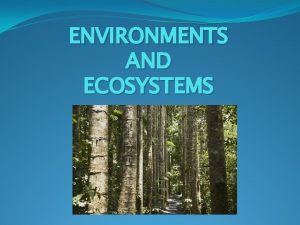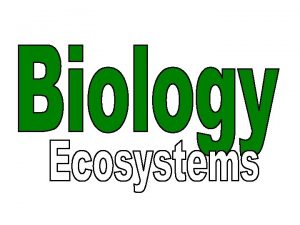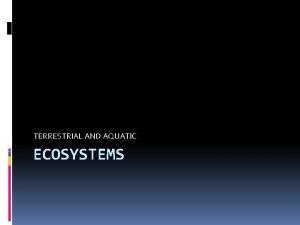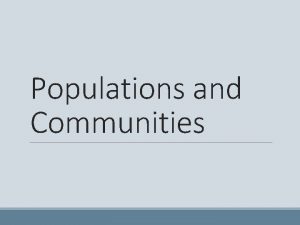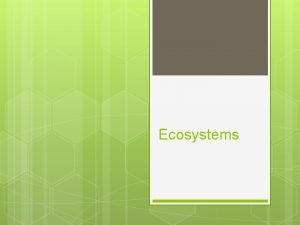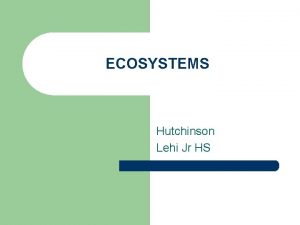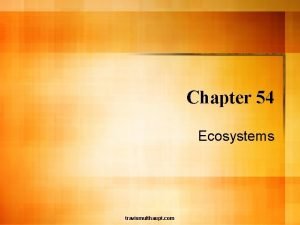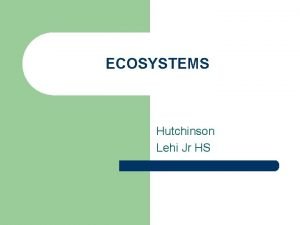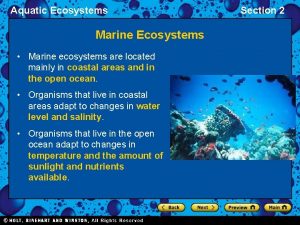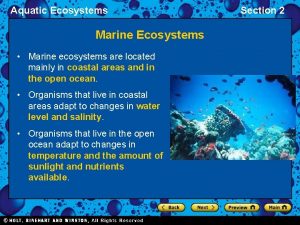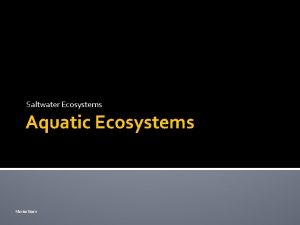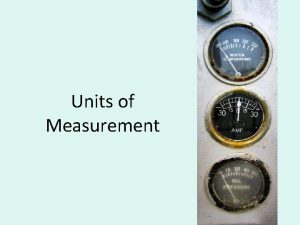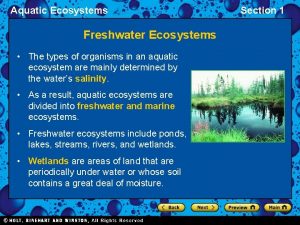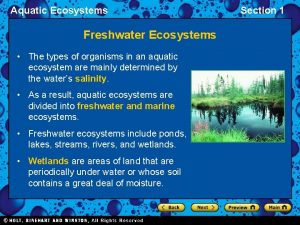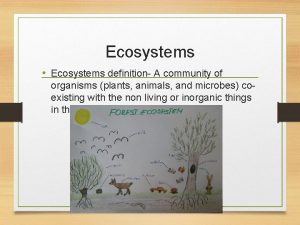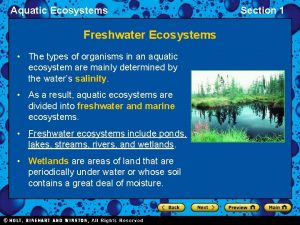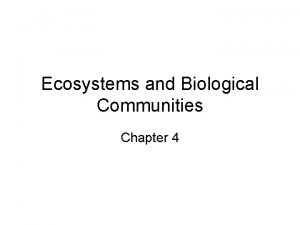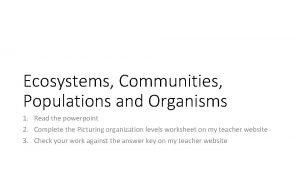Ecosystems Communities Organisms and their Environments Units 1214





























































































- Slides: 93

Ecosystems & Communities: Organisms and their Environments Units 12&14 1

Ecosystems have living and non-living components 14. 1 2

Ecosystem �Living organisms. �Non-Living Environment 3

4

5

�The biotic environment of all the living organisms in an area. �can be any size and diversity – bacteria �- single celled organisms �- insects �- other larger sized creatures Communities 6

�The abiotic (aka non-living or physical) environment �, the chemical resources �the physical conditions, Habitat 7

Different species interacting together at the same place and time Examples of ecosystems 8

Ecosystem 9

�An ecosystem is made of two components: �the biotic environment, �the habitat Ecosystem 10

Ecosystems have living and non-living components 14. 2 Biomes 11

Biomes occur around the world, determined by temperature and rainfall. �Average �seasonal 12

13

14

15

Tropical Rain Forest 16

Tropical Rain Forest �Equatorial: 17

Tropical Rain Forest �Rainfall: 18

Indicator Species 19

Tropical Rain Forest – Indicator Plant Species 20

Tropical Rain Forest – Indicator Gorilla Animal Species Gorilla gorilla Orangutan (Pongo pygmaeus) Spider Monkey Ateles geoffreyi 21

Tropical Rain Forest – Indicator 2 -toed sloth. Species Animal Cholepus hoffmanni Three-toed Sloth (Bradypus variegatus) with baby - Costa Rica 22

Tropical Rain Forest – Indicator Animal Species Collared Aracari Pteroglossus torquatus 23

Grasslands (Prairie) 24

Grasslands (Prairie) �Temperate 25

Grasslands (Prairie) 26

�Dry: �Wet: Grasslands (Prairie) 27

�Species: Grasslands (Prairie) 28

Grasslands– Indicator Plant Species Old Field Habitat, Ohio Grassland, North Dakota Ironweed (Vernonia sp. ) with Hedge Bindweed 29 Vine (Calystegia sepium)

Grasslands– Indicator Plant Species Ironweed (Vernonia sp. ) Joe Pye Weed Eupatorium purpureum 30

Grasslands – Indicator Plant Species Common Teasel Dipsacus fullonum Queen Anne's Lace (Daucus carota) 31

Grasslands – Indicator Animal Species Bison (Bison bison) on the range, Theodore Roosevelt National Park, North Dakota 32

Grasslands – Indicator Animal Przewalski's horse (Equus caballus Species przewalskii), The Wilds, Ohio 33

Grasslands – Indicator Animal Species 34

Taiga 35

�Cold Temperate Taiga 36

�Seasons Taiga 37

Balsam Fir Abies balsamea Taiga – Indicator Plant Species Black Spruce Picea mariana 38

Taiga – Indicator Plant Species White Poplar Populus alba Jack Pine Pinus banksiana Paper Birch Betula papyrifera 39

Taiga – Indicator Animal Species American Black Bear Ursus americanus Bald Eagle Haliaeetus leucocephalus 40

Taiga – Indicator Animal Species Snowshoe Rabbit Lepus americanus Long-eared Owl Aiso otus 41

Desert 42

Desert – Evaporation Exceeds Precipitation 43

Desert – Indicator Plant Species 44

Desert – Indicator Plant Species Fishhook Cactus Mammillaria microcarpa Saguaro Cactus Carnegiea gigantea 45

Trichomes Desert – Indicator Plant Species 46

Zebratail Lizard - Callisaurus draconides Desert – Indicator Animal Species 47

Desert – Indicator Animal Species Rock hyrax (Procavia capensis) 48

Bactrian Camel, Camelus bactrianus Desert – Indicator Animal Species 49

Temperate Deciduous Forest 50

Temperate Deciduous Forest �Biome of this region 51

Oaks (Quercus sp. ) Temperate Deciduous Forest Indicator Plant Species Dutchman's-Breeches Dicentra cucullaria 52

Sassafras albidum Redbud Cercis canadensis Temperate Deciduous Forest Indicator Plant Species 53

Temperate Deciduous Forest – Succession 54

Temperate Deciduous Forest Indicator Animal Species American Toad Bufo americanus Box Turtle 55

Eastern Chipmunk Tamias striatus Eastern Gray Squirrel Sciurus carolinensis Temperate Deciduous Forest Indicator Animal Species 56

Temperate Deciduous Forest Indicator Animal Species Yellow-breasted chat Icteria virens 57

Anaktuvuk Pass, Alaska Tundra 58

�Ground is permanently frozen Tundra 59

Arctic Tundra Wildflowers - Alaska Tundra – Indicator Plant Species 60

Lichen Polytrichum Moss (photographed in Ohio, not on the Tundra) Tundra – Indicator Plant Species 61

Reindeer Rangifer tarandus Tundra – Indicator Animal Species 62

Tundra – Indicator Animal Species Caribou On Autumn Tundra Denali National Park Alaska 63

Savanna 64

◦ Between a tropical rainforest and desert biome Savanna 65

Baobab Adansonia digitata Umbrella Thorn Acacia tortillis Savanna – Indicator Plant Species 66

Savanna – Indicator Animal Species Savanna Elephant Loxodonta africana Black Mamba Dendroaspis polylepis Lion Panthera leo 67

Chaparral 68

�California coastal regions Chaparral 69

Blue Oak Quercus douglasii Common Sagebrush Artemisia tridentata Olive Tree Olea europaea Chaparral – Indicator Plant Species 70

Black-tailed Jackrabbit Lepus californicus Golden Jackal Canis aureus Spotted Skunk Spilogale gracilis Chaparral – Indicator Animal Species 71

�Inland lakes, rivers and wetlands �low salt concentration — usually less than 1% The Freshwater Biome 72

From left: a view across Manzanita Lake toward Mt. Lassen, California; a forest pond near Donnelly, Idaho; a Great Blue Heron; Paranagat Lake, southeastern Nevada. • Formed by runoff from snowmelt and rainfall The Freshwater Biome – Ponds and Lakes 73

Lakes 74

From left: Mc. Arthur-Burney Falls State Park, California; trout; Green River, Utah; Brooks River, Alaska. • Flowing water moving in one direction The Freshwater Biome – Streams and Rivers 75

Streams and Rivers 76

From left: Pescadero Marsh, California; coastal marsh at Umpqua Dunes, Oregon; trees and bogs on Esther Island, Alaska. • Standing water with abundant plant life • can include salt marshes on the edge of oceans The Freshwater Biome - Wetlands 77

Wetlands 78

From left: mussels, worms, and a spider crab at a hydrocarbon seep community in the Gulf of Mexico; a sea fan and brain coral in the Florida Keys National Marine Sanctuary; a school of Atlantic amberjack off North Carolina. • Deep oceans and continental shelf areas just off the coast The Marine Biome - Oceans 79

�Salt water The Marine Biome 80

From left: reef life in the Gulf of Aqaba, Red Sea; a reef at Fanning Island atoll in the central Pacific; a reef in the Florida Keys National Marine Sanctuary. • Warm shallow salt water near islands and continents The Marine Biome – Coral Reefs 81

Coral Reefs 82

From left: Mangrove roots, south Florida; wetlands and tidal streams in the Ashe Island area, ACE Basin National Estuarine Research Reserve, South Carolina; a salt marsh in Winyah Bay National Estuarine Research Reserve, South Carolina. • Freshwater streams merge with oceans in shallow areas The Marine Biome – Estuaries and Wetlands 83

Estuaries 84

These are the biomes, in order of their productivity (highest first) 1. estuaries and tropical rain forest (highest) 2. temperate forest 3. agricultural land 4. temperate grassland 5. lakes and streams 6. coastal zone 7. tundra 8. open ocean 9. desert (lowest) Ecological Notes 85

Biomes Terrestrial Aquatic �Tropical �Freshwater Rain Forest �Savannah �Desert �Chaparral �Temperate Forest �Prairie �Taiga �Tundra Lakes and Ponds �Rivers and Streams �Wetlands �Open Oceans �Coral Reefs �Estuaries 86

1. Sunlight 2. Nutrients 3. Warm temperatures 4. Water Ecological Notes 87

Biomes Video 88

�Biomes are the major ecological communities of earth, characterized by the vegetation present. �Different biomes result from differences in temperature and precipitation, �season to season variation. Biomes Summary 89

�How are aquatic biomes determined? Challenge 90

Physical forces interacting create weather 14. 3 Global air circulation patterns create deserts and rain forests. 91

92

93
 Ecosystems and communities chapter 4 answer key
Ecosystems and communities chapter 4 answer key Chapter 4 ecosystems and communities
Chapter 4 ecosystems and communities Communities biomes and ecosystems
Communities biomes and ecosystems Steps of secondary succession
Steps of secondary succession Parasitism
Parasitism Unicellular and multicellular organisms
Unicellular and multicellular organisms Competitive interaction
Competitive interaction Ponizej podano zaokraglenia do czesci dziesietnych liczb
Ponizej podano zaokraglenia do czesci dziesietnych liczb General physics
General physics Phy 1214
Phy 1214 Battaglia di bouvines schema
Battaglia di bouvines schema 1214 no tenemos a los cobardes
1214 no tenemos a los cobardes General physics
General physics General physics measurement
General physics measurement Vx=vox+axt
Vx=vox+axt Phy 1214
Phy 1214 Year 1214
Year 1214 Principles of ecology organisms and their relationships
Principles of ecology organisms and their relationships Principles of ecology chapter 2 section 1 answer key
Principles of ecology chapter 2 section 1 answer key Chapter 2 section 1 organisms and their relationships
Chapter 2 section 1 organisms and their relationships Section 1 organisms and their relationships answer key
Section 1 organisms and their relationships answer key Chapter 2 section 1 organisms and their relationships
Chapter 2 section 1 organisms and their relationships 5 levels of organisms
5 levels of organisms Chapter 2 section 1 organisms and their relationships
Chapter 2 section 1 organisms and their relationships Bocouture doses
Bocouture doses Variable costing income statement
Variable costing income statement 5 physical quantities and their si units
5 physical quantities and their si units Where do organisms get their traits?
Where do organisms get their traits? Where do all organisms get their energy
Where do all organisms get their energy The process of grouping things based on similarities
The process of grouping things based on similarities Organisms that make their own food
Organisms that make their own food International business: environments & operations
International business: environments & operations Internal and external environment of the school system
Internal and external environment of the school system Online search agents and unknown environments
Online search agents and unknown environments Micro marketing environment
Micro marketing environment International business chapter 5
International business chapter 5 International business environments and operations
International business environments and operations Exercise in hot and cold environments
Exercise in hot and cold environments International business environments and operations
International business environments and operations Machine reference model in cloud computing
Machine reference model in cloud computing Components of business environment
Components of business environment Chapter 13 natural environments of europe
Chapter 13 natural environments of europe Stable prediction across unknown environments
Stable prediction across unknown environments Psychologically informed environments
Psychologically informed environments Psychologically informed environments
Psychologically informed environments Creating supportive environments smoking
Creating supportive environments smoking High quality supportive environments
High quality supportive environments Chapter 13 natural environments of europe
Chapter 13 natural environments of europe Jonassen constructivism
Jonassen constructivism Chapter 7 natural environments of north america
Chapter 7 natural environments of north america Economic activity
Economic activity Ibm spectrum protect for virtual environments
Ibm spectrum protect for virtual environments Marketing environments
Marketing environments Information-intensive operating environments
Information-intensive operating environments Story openers
Story openers Global marketing environment
Global marketing environment Diverse learning environments survey
Diverse learning environments survey Enabling environments eyfs
Enabling environments eyfs Diverse learning environments survey
Diverse learning environments survey Epiphytes plants
Epiphytes plants 3 aquatic biomes
3 aquatic biomes Chapter 55 ecosystems and restoration ecology
Chapter 55 ecosystems and restoration ecology Chapter 42 ecosystems and energy
Chapter 42 ecosystems and energy Chapter 3 lesson 3 biomes and aquatic ecosystems
Chapter 3 lesson 3 biomes and aquatic ecosystems Frog life cycle
Frog life cycle Nutrient chain foldable
Nutrient chain foldable Lesson 3 energy and matter in ecosystems answer key
Lesson 3 energy and matter in ecosystems answer key Lab food chains and energy in ecosystems
Lab food chains and energy in ecosystems Flow of energy
Flow of energy Chapter 55 ecosystems and restoration ecology
Chapter 55 ecosystems and restoration ecology Biomes and aquatic ecosystems
Biomes and aquatic ecosystems Water pollution and ecosystems
Water pollution and ecosystems 5 oceans in the world
5 oceans in the world Act 1 prologue romeo and juliet
Act 1 prologue romeo and juliet Hroc group
Hroc group Communities culture and heritage
Communities culture and heritage Communities and biomes virtual lab answers
Communities and biomes virtual lab answers Magnesium cycle in marine ecosystem
Magnesium cycle in marine ecosystem Lesson outline lesson 2 aquatic ecosystems answer key
Lesson outline lesson 2 aquatic ecosystems answer key Chapter 3 section 3 aquatic ecosystems
Chapter 3 section 3 aquatic ecosystems Ecosystem living and nonliving things
Ecosystem living and nonliving things Objectives of ecosystem
Objectives of ecosystem Ocean food chain
Ocean food chain Biodiversity
Biodiversity Chapter 4 lesson 2 energy flow in ecosystems answer key
Chapter 4 lesson 2 energy flow in ecosystems answer key Energy in ecosystems lesson 3 answer key
Energy in ecosystems lesson 3 answer key Interactions in the environment grade 7
Interactions in the environment grade 7 Section 3 energy in ecosystems
Section 3 energy in ecosystems Ecology title page
Ecology title page Biotic factors in ecosystem
Biotic factors in ecosystem Ecosystems jeopardy
Ecosystems jeopardy Distribution of ecosystems
Distribution of ecosystems Human impact on terrestrial ecosystems
Human impact on terrestrial ecosystems Aquatic ecosystems webquest
Aquatic ecosystems webquest
